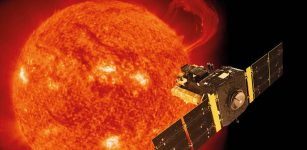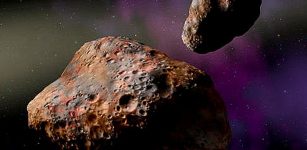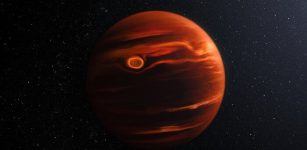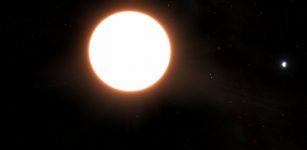Cassini Probe Reveals New Sculpting In Saturn Rings
Eddie Gonzales Jr. – MessageToEagle.com – As NASA’s Cassini dove close to Saturn in its final year, the spacecraft provided intricate detail on the workings of Saturn’s complex rings, new analysis shows.
Although the mission ended in 2017, science continues to flow from the data collected. Findings include fine details of features sculpted by masses embedded within the rings. Textures and patterns, from clumpy to strawlike, pop out of the images, raising questions about the interactions that shaped them. New maps reveal how colors, chemistry and temperature change across the rings.
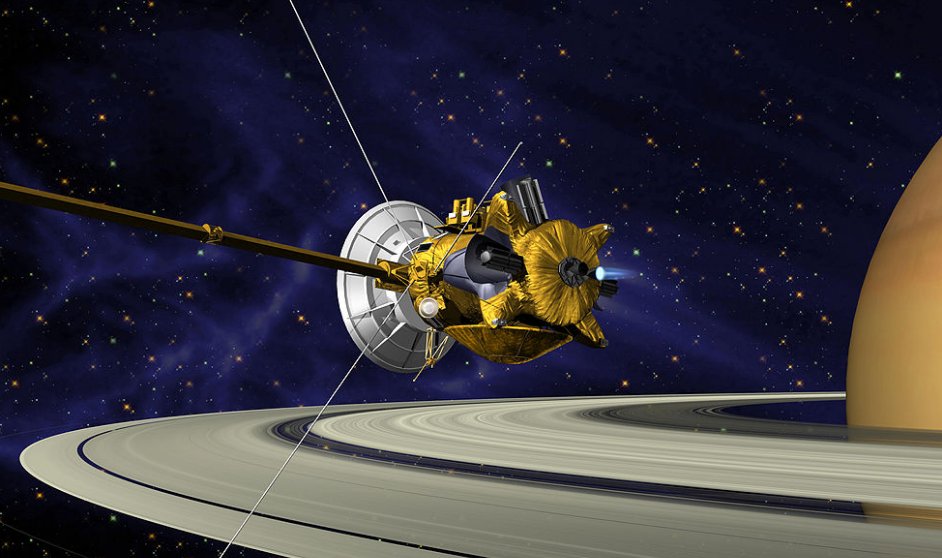 Concept of Cassini during the Saturn Orbit Insertion (SOI) maneuver, just after the main engine has begun firing. Image credit: NASA/JPL
Concept of Cassini during the Saturn Orbit Insertion (SOI) maneuver, just after the main engine has begun firing. Image credit: NASA/JPL
Like a planet under construction inside a disk of protoplanetary material, tiny moons embedded in Saturn’s rings (named A through G, in order of their discovery) interact with the particles around them. In that way, the paper provides further evidence that the rings are a window into the astrophysical disk processes that shape our solar system.
Scientists conclude that at the outer edge of the main rings, a series of similar impact-generated streaks in the F ring have the same length and orientation, showing that they were likely caused by a flock of impactors that all struck the ring at the same time. This shows that the ring is shaped by streams of material that orbit Saturn itself rather than, for instance, by cometary debris (moving around the Sun) that happens to crash into the rings.
“These new details of how the moons are sculpting the rings in various ways provide a window into solar system formation, where you also have disks evolving under the influence of masses embedded within them,” said lead author and Cassini scientist Matt Tiscareno of the SETI Institute in Mountain View, California.
At the same time, new puzzles have arisen and old mysteries have deepened with the latest research. The close-up ring images brought into focus three distinct textures – clumpy, smooth and streaky – and made it clear that these textures occur in belts with sharp boundaries. But why? In many places the belts aren’t connected to any ring characteristics that scientists have yet identified.
 A false-color image mosaic shows Daphnis, one of Saturn’s ring-embedded moons, and the waves it kicks up in the Keeler gap. Images collected by Cassini’s close orbits in 2017 are offering new insight into the complex workings of the rings. Credit: NASA/JPL-Caltech/Space Science Institute
A false-color image mosaic shows Daphnis, one of Saturn’s ring-embedded moons, and the waves it kicks up in the Keeler gap. Images collected by Cassini’s close orbits in 2017 are offering new insight into the complex workings of the rings. Credit: NASA/JPL-Caltech/Space Science Institute
“This tells us the way the rings look is not just a function of how much material there is,” Tiscareno said. “There has to be something different about the characteristics of the particles, perhaps affecting what happens when two ring particles collide and bounce off each other. And we don’t yet know what it is.”
The data analyzed were gathered during the Ring Grazing Orbits (December 2016 to April 2017) and the Grand Finale (April to September 2017), when Cassini flew just above Saturn’s cloud tops. As the spacecraft was running out of fuel, the mission team deliberately plunged it into the planet’s atmosphere in September 2017.
Cassini’s Visible and Infrared Mapping Spectrometer (VIMS) uncovered another mystery. The spectrometer, which imaged the rings in visible and near-infrared light, identified unusually weak water-ice bands in the outermost part of the A ring. That was a surprise, because the area is known to be highly reflective, which usually is a sign of less-contaminated ice and thus stronger water ice bands.
The new spectral map also sheds light on the composition of the rings. And while scientists already knew that water ice is the main component, the spectral map ruled out detectable ammonia ice and methane ice as ingredients. But it also doesn’t see organic compounds – a surprise, given the organic material Cassini has discovered flowing from the D ring into Saturn’s atmosphere.
“If organics were there in large amounts – at least in the main A, B and C rings – we’d see them,” said Phil Nicholson, Cassini VIMS scientist of Cornell University in Ithaca, New York. “I’m not convinced yet that they are a major component of the main rings.”
Original story – here.
Written by Eddie Gonzales Jr. – MessageToEagle.com Staff

